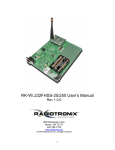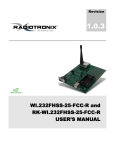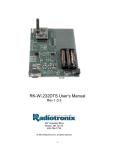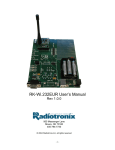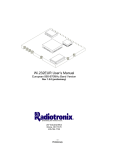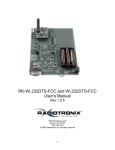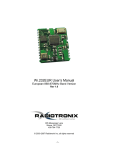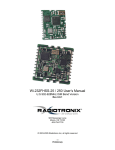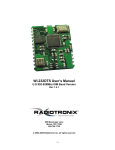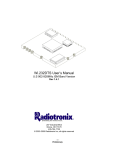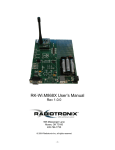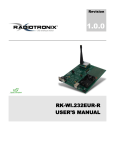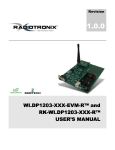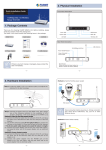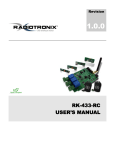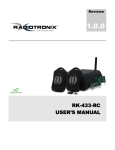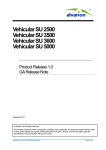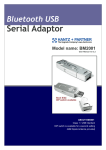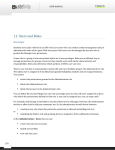Download RK-Wi.232FHSS-25-FCC™ and FCC-Wi.232FHSS
Transcript
RK-Wi.232FHSS-25-FCC™ and FCC-Wi.232FHSS-25™ User’s Manual Rev 1.0.3 905 Messenger Ln. Moore, OK 73160 405-794-7730 © 2004 Radiotronix Inc, all rights reserved -i- RK-Wi.232FHSS-25-FCC Rapid Development Kit User’s Manual Document Control Created By Engineering Review Marketing Review Approved – Engineering Approved – Marketing Tom Marks 3/10/2006 Revision History Revision 1.0.0 1.0.1 1.0.3 Author TRM TRM TRM Date 3/10/06 3/11/06 3/23/06 © 2002-6 Radiotronix Inc, all rights reserved Description Document Created from RK/DTS FCC 1.0.5 Corrected ANT-916-12A p/n -1- 12/8/2006 RK-Wi.232FHSS-25-FCC Rapid Development Kit User’s Manual Table of Contents 1 Description ...............................................................................................................................3 2 RApid Development Kit Setup .................................................................................................3 3 Using the RK-Wi.232FHSS-FCC Evaluation Software............................................................4 3.1 Module Selection............................................................................................................ 4 3.2 COM Port Setup and Selection. ..................................................................................... 4 3.3 Wireless Chat Page. ...................................................................................................... 5 3.4 Non-Volatile Register Page............................................................................................ 5 3.5 Volatile Register Page.................................................................................................... 6 4 Using the Evaluation Software.................................................................................................7 4.1 Setting Register Values.................................................................................................. 7 4.2 Diagnostic Mode Commands ......................................................................................... 7 5 Notes........................................................................................................................................8 5.1 Microsoft Windows / Hilgraeve HyperTerminal .............................................................. 8 5.2 Loopback Mode.............................................................................................................. 9 6 PCB Layout Diagrams ...........................................................................................................10 6.1 RK-Wi.232FHSS-FCC™ Evaluation (Rapid Development) Board Layout ................... 10 6.2 FCC-Wi.232FHSS (EValuation Module) Layout .......................................................... 11 7 Schematic Diagrams..............................................................................................................13 7.1 FCC-Wi232FHSS-25 Schematic Diagram ................................................................... 13 7.2 RK-Wi.232FHSS-25-FCC™ Evaluation (Rapid Development) Schematic Diagram.... 14 8 Usage Guidelines for FCC Compliance.................................................................................15 8.1 Antenna Selection ........................................................................................................ 15 8.2 Module Modification ..................................................................................................... 15 8.3 End Product Labeling Requirements ........................................................................... 15 8.4 Additional FCC Testing Requirements......................................................................... 15 9 FCC Statements of Compliance ............................................................................................16 9.1 Statement and Conditions of Modular Compliance...................................................... 16 9.2 Customer FCC Warning Requirements ....................................................................... 17 9.3 Notices of Limitation ..................................................................................................... 17 © 2002-6 Radiotronix Inc, all rights reserved -2- 12/8/2006 RK-Wi.232FHSS-25-FCC Rapid Development Kit User’s Manual 1 Description The RK-Wi.232FHSS-25-FCC™ is a rapid-development/evaluation kit, which contains FCC preauthorized FCC-Wi.232FHSS-25™ modules. When used within the guidelines presented in this document, no FCC part 15 transmitter testing/certification of the FCC-Wi.232FHSS-25™ is necessary in the end product. Included in the kit is: • 1-Rapid Development Case. • 1-Rapid Development Utility and Documentation CD. • 2-Wi.232 Rapid Development Boards. • 2-FCC-Wi.232FHSS-25™ pinned modules. • 2-900 MHz antennas. • 2-RS-232 cables. • 2-USB cables. • 6-AAA batteries. • Startup Guide. 2 RApid Development Kit Setup • Insert the AAA batteries into the evaluation PCB, observing the correct polarity. • Insert a FCC-Wi.232FHSS-25™ module into one of the evaluation boards, observing the correct orientation (see later in this document). The correct orientation of the module is with the antenna connector closest to the edge of the evaluation board. Make sure it is seated fully and correctly. • Insert the other FCC-Wi.232FHSS-25™ module into the other evaluation board, also observing the correct polarity. • Connect antennas to FCC-Wi.232FHSS-25™ modules. • Connect evaluation boards to computers. If using USB communications, populate USB jumpers and remove RS-232 jumpers. If using RS-232 communications, populate RS-232 jumpers and remove USB jumpers. • Install the RK-Wi.232FHSS-FCC™ Windows software. If already installed, skip this step. • Run the RK-Wi.232FHSS-FCC™ software, select 2400 baud operation and navigate to the “Wireless Chat” tab. • Power-On both evaluation boards, verifying that the version/copyright information is echoed to the screen from both modules. • Chat back and forth between evaluation boards, verifying that serial and RF communications are successful. • IMPORTANT NOTE FOR HYPERTERMINAL USERS: See section 4.1 © 2002-6 Radiotronix Inc, all rights reserved -3- 12/8/2006 RK-Wi.232FHSS-25-FCC Rapid Development Kit User’s Manual 3 Using the RK-Wi.232FHSS-FCC Evaluation Software The software supplied with the RK-Wi.232FHSS-25-FCC™ RadKit is used to read and set the volatile and non-volatile registers with the Wi.232FHSS-25™ module. Refer to the Wi.232FHSS™ User’s Manual for more information on the register settings. 3.1 Module Selection The RK-Wi.232FHSS-FCC™ evaluation software supports both the 25mW and 250mW versions of frequency hopping modules. Select the Wi.232FHSS-25™ module type. 3.2 COM Port Setup and Selection. Upon starting the RK-Wi.232FHSS-FCC™ evaluation software, you will be presented with a COM port selection dialog box. If you are using the USB interface, make sure that the evaluation board is already connected to the computer via the USB cable before you start the software. This will ensure that the virtual COM port which is assigned to the USB to UART bridge controller by Windows is visible in the COM port selection list. The first time you start the RK-Wi.232FHSS-FCC™ evaluation software, the Baud Rate should be left at 2400 baud, since this is the factory default baud rate setting for the module. Tip: The RK-Wi.232FHSS-FCC™ evaluation software does not autodetect the baud rate of the module. If you have changed the NonVolatile Data Rate register, you will have to select the baud rate you set this register to when you start the RK-Wi.232FHSS-FCC™ evaluation software. © 2002-6 Radiotronix Inc, all rights reserved -4- 12/8/2006 RK-Wi.232FHSS-25-FCC Rapid Development Kit 3.3 User’s Manual Wireless Chat Page. The Wireless Chat page in the RK-Wi.232FHSS-FCC™ evaluation software demonstrates the capability of the FCC-Wi.232FHSS25™ to be used as a wireless communications link. The Rapid Development kit works as a wireless chat link with no register changes required, out of the box. To Use Wireless Chat: Type a message in the lower text field next to the “Clear Output Window” and press Enter. The text you typed will be displayed on the remote system, prefixed with a Node Identifier if the “Send Node Identifier” checkbox is checked. 3.4 Non-Volatile Register Page. The Non-Volatile Register page in the evaluation software allows you to change the default settings which will be loaded when the module is powered on. Tip: If you change the NonVolatile Data Rate setting, you will have to select this baud rate when you restart the RK-Wi.232FHSS-25FCC™ evaluation board/module. © 2002-6 Radiotronix Inc, all rights reserved -5- 12/8/2006 RK-Wi.232FHSS-25-FCC Rapid Development Kit 3.5 User’s Manual Volatile Register Page In this page, you can change the Volatile settings of the module. Values programmed into these registers are lost of powerdown. The page also provides a means of displaying the Diagnostic Window, a special dialog box that allows the user to place the module into a variety of diagnostic modes. © 2002-6 Radiotronix Inc, all rights reserved -6- 12/8/2006 RK-Wi.232FHSS-25-FCC Rapid Development Kit User’s Manual 4 Using the Evaluation Software 4.1 Setting Register Values. On both the Volatile and Non-Volatile pages, the registers are labeled by function. To set a register value, select the value from the options available for that register and click the “Write” button. To perform a read of that register, simply click the “Read” button. Descriptions of the register functions can be found in the Wi.232FHSS Users Manual. 4.2 Diagnostic Mode Commands There are a special class of commands available through the evaluation software. These controls are accessed by clicking the “Show” button in the “Diagnostic Window” group located on the “Volatile Registers” page as seen below. These commands place the module into special diagnostic modes that can be used to test the module’s performance, or to activate the transmitter for RF testing purposes. NOTE: once a module executes a diagnostic command, it should be reset or have the power cycled to return to normal operation. 4.2.1 Transmit Diagnostic Transmit Diagnostic consists of the controls located in the “Transmit Diagnostic” group. The transmit diagnostic group is broken into two smaller sub-groups. The left side is used to observe static transmitter characteristics- that is, when the “TX 1-Channel Diag” button is clicked, it stops the module from hopping frequencies. The radio buttons on the left allow quick selection of the transmitter’s channel/frequency. Once activated, a “…1010101010101…” bit pattern is transmitted for bit error testing or RF carrier analysis. This single-channel transmit diagnostic mode can be used with the receive diagnostic. The right side is used to observe dynamic transmitter characteristics. Dynamic transmitter operation allows the module to hop frequencies as it transmits. The “Hop Set” radio button selects the hop sequence (analogous to a channel, values are 0-5) to be used when hopping. Dynamic transmitter mode cannot be used to provide a carrier for the Receive Diagnostic. Clicking the “Tx FHSS Diag” button sends the new hopping sequence value to the module and activates the transmitter. The “Start Hop” and “Stop Hop” buttons start and stop the diagnostic hopping, respectively. In the middle, the light-orange colored box controls the power and modulation characteristics of the transmitter. For the FCC-Wi.232FHSS-25™, there are four power settings of increasing intensity: Low, Mid-Low, Mid-High, and High. The “Mod Off” and “Mod On” buttons switch the carrier’s modulation off and on, respectively. © 2002-6 Radiotronix Inc, all rights reserved -7- 12/8/2006 RK-Wi.232FHSS-25-FCC Rapid Development Kit 4.2.2 User’s Manual Receive Diagnostic Receive Diagnostic consists of four radio buttons which allow the selection of frequency, the “Set RX Diag” button which activates the module’s receiver and begins a bit error test, and the result box, which shows the number of bit errors recorded in the last test. The “Set RX Diag” button switches on the receiver using the channel and mode selected in the channel selector and transceiver mode controls. The module stops hopping frequency and stays stationary. It will wait for a “10101010...” bit pattern at the RF interface. If one is not received, the module could remain in an infinite loop waiting for this start condition. If this happens, simply cycle the power to return the module to normal operation. If a “…1010101010101…” bit pattern is received, the BER test will return the number and percent of bit errors. This information is displayed in the panel below the “Set RX Diag” button. The Receive Diagnostic mode can be used in conjunction with another module operating in “Tx 1Channel Diag” mode. Both transmitting and receiving modules must be on the same frequency and have the same baud rate selected for proper operation of the bit error test. 5 Notes 5.1 Microsoft Windows / Hilgraeve HyperTerminal The RK-Wi.232FHSS-25-FCC™ Evaluation Kit can be used with HyperTerminal to receive and transmit RS-232 data and send files using file transfer protocols such as ZMODEM. HyperTerminal and many other terminal programs assert RTS by default. On the evaluation board, the RTS line is tied to the CMD pin on the module. When the CMD pin is held low, which is the case when the RTS line is asserted, the module will be placed in command mode. In command mode, all UART data sent to the module will be interpreted as commands and will NOT be sent to the RF engine for transmission. Additionally, if an evaluation board is switched on in the presence of an asserted RTS line, it will perform a full hardware and flash reset to the factory defaults. To use the evaluation board with HyperTerminal or other terminal program, you must first remove the jumpers from pins 7+8 of JP2, if you are using an RS-232 connection to your PC, or JP3, if you are using a USB connection to your PC. Removing this jumper will disconnect the RTS line from the CMD pin on the module, allowing normal operation. © 2002-6 Radiotronix Inc, all rights reserved -8- 12/8/2006 RK-Wi.232FHSS-25-FCC Rapid Development Kit 5.2 User’s Manual Loopback Mode The RK-Wi.232FHSS-25-FCC™ kit can be operated in a loopback mode by configuring the COM jumpers in such a way as to link together the TXD and RXD lines to and from the module in the remote evaluation board. Using this mode, the user can send data from their local evaluation board and have it re-transmitted back to them by the remote evaluation board. The maximum baud rate allowed in loopback mode is 38400 baud for point to point (single-endpoint addressing) communications only. It should also be noted that this method of looping back the communications bypasses the module’s flow control, which can cause loss of data. When using loopback mode, ensure that your data does not exceed 144 bytes. Data cannot be streamed to a board in loopback mode. Loopback mode using the RS232 jumpers: © 2002-6 Radiotronix Inc, all rights reserved -9- 12/8/2006 RK-Wi.232FHSS-25-FCC Rapid Development Kit User’s Manual 6 PCB Layout Diagrams 6.1 RK-Wi.232FHSS-FCC™ Evaluation (Rapid Development) Board Layout © 2002-6 Radiotronix Inc, all rights reserved - 10 - 12/8/2006 RK-Wi.232FHSS-25-FCC Rapid Development Kit 6.2 User’s Manual FCC-Wi.232FHSS (EValuation Module) Layout JP1 Pin 1 JP2 Pin 1 NOTE: Pin 1 of the FCC-Wi.232FHSS-25™ module’s JP2 aligns with Pin 1 of JP6 on the evaluation board. The following table lists the pin numbers and their assignments © 2002-6 Radiotronix Inc, all rights reserved - 11 - 12/8/2006 RK-Wi.232FHSS-25-FCC Rapid Development Kit Pin Name JP2 Pin 1 JP2 Pin 2 JP2 Pin 3 JP2 Pin 4 JP2 Pin 5 JP2 Pin 6 JP2 Pin 7 JP2 Pin 8 JP2 Pin 9 JP2 Pin 10 JP2 Pin 11 JP2 Pin 12 JP1 Pin 1 JP1 Pin 2 JP1 Pin 3 JP1 Pin 4 JP1 Pin 5 JP1 Pin 6 JP1 Pin 7 JP1 Pin 8 JP1 Pin 9 JP1 Pin 10 JP1 Pin 11 JP1 Pin 12 User’s Manual Pin Description 4V to 12V Vdd RxD0, Wi.232FHSS-25™ RxD pin TxD0, Wi.232FHSS-25™ TxD pin CTS0, Wi.232FHSS-25™ CTS pin CMD (Active Low), Wi.232FHSS-25™ CMD pin RxD1 – Reserved for Future – No Connect TxD1 – Reserved for Future – No Connect RTS1 – Reserved for Future – No Connect DTR1 – Reserved for Future – No Connect DTR1* - Reserved for Future – No Connect GND GND GND GND AD1 – Buffer Empty (BE) AD0 – Command Response (CMD_RSP) RSSI PD5 – Exception (EX) PD4 – Reserved for Future – No Connect PD3 – Reserved for Future – No Connect PD2 – Reserved for Future – No Connect PD1 – Reserved for Future – No Connect GND GND Table 1, FCC-Wi.232FHSS-25™ Module Pinout © 2002-6 Radiotronix Inc, all rights reserved - 12 - 12/8/2006 RK-Wi.232FHSS-25-FCC Rapid Development Kit User’s Manual 7 Schematic Diagrams 7.1 FCC-Wi232FHSS-25 Schematic Diagram © 2002-6 Radiotronix Inc, all rights reserved - 13 - 12/8/2006 RK-Wi.232FHSS-25-FCC Rapid Development Kit 7.2 User’s Manual RK-Wi.232FHSS-25-FCC™ Evaluation (Rapid Development) Schematic Diagram © 2002-6 Radiotronix Inc, all rights reserved - 14 - 12/8/2006 RK-Wi.232FHSS-25-FCC Rapid Development Kit User’s Manual 8 Usage Guidelines for FCC Compliance The FCC-Wi232FHSS modules included in this rapid development kit have been awarded a FCC modular approval. That means that this module, when integrated into your end product, requires no FCC part 15 testing as long as the following guidelines are met. Failure to meet any of the following guidelines will prevent the inheritance of the FCC modular certification. 8.1 Antenna Selection In order to maintain compliance with FCC regulations, an antenna with no more than 4dBi gain must be used. This module has been tested with the following antennas: Radiotronix Part Number Antenna Type Antenna Gain ANT-915-04A RP ¼ Wave Helical 2dBi ANT-915-02A RP ¼ Wave Whip 2dBi ANT-915-06A RP ½ Wave Dipole 2dBi ANT-916-12A RP ½ Wave Whip Magnetic Base 4dBi An approved antenna must be directly attached to the module’s reverse-polarity SMA connector in the final application to inherit the FCC modular certification. The ANT-916-12A antenna comes with an integrated extension cable. 8.2 Module Modification The module must not be physically altered in any way. If any connections are made to the module that bypass the module pins, socket, or antenna connector, the FCC modular certification cannot be inherited. 8.3 End Product Labeling Requirements Pursuant to FCC public notice DA 00-1407, the end product must be labeled on its exterior with the following verbiage: “Contains FCC ID: Q7V-3F090008X” 8.4 Additional FCC Testing Requirements While the module’s FCC certification can be inherited (presuming the guidelines are met), additional testing will be required to achieve full FCC compliance for your end-product. The integrator is required to perform unintentional radiator testing on the final product per FCC sections 15.107 and 15.109. Additional, product-specific testing might be required. Please contact the FCC regarding regulatory requirements for your application. © 2002-6 Radiotronix Inc, all rights reserved - 15 - 12/8/2006 RK-Wi.232FHSS-25-FCC Rapid Development Kit User’s Manual 9 FCC Statements of Compliance 9.1 Statement and Conditions of Modular Compliance FCC NOTICE (FCC ID: Q7V-3F090008X) This device complies with the rules set forth in Part 15 by the Federal Communications Commission. Operation is subject to the following two conditions: 1) This device may not cause harmful interference 2) This device must accept any interference received, including interference that may cause undesired operation. Any changes or modifications not expressly approved by Radiotronix, Inc. could void the user’s authority to operate the equipment. The FCC-Wi.232FHSS-25™ module is provided with an inheritable FCC Modular Certification. This certification may be inherited in an end-user product, negating the need for FCC part 15 intentional radiator testing on this module, provided that the following guidelines are met: 1. An approved antenna must be directly coupled to the module’s RP-SMA connector. 2. The module must not be modified in any way. Coupling of external circuitry must not bypass the provided connectors. 3. End product must be externally labeled with “Contains FCC ID: Q7V3F090008X” 4. The end product’s user’s manual must contain an FCC statement equivalent to that listed in section 9.2 of this manual. 5. The antenna used for this transceiver must not be co-located or operating in conjunction with any other antenna or transmitter. 6. The integrator must not provide any information to the end-user on how to install or remove the module from the end-product. The integrator is required to perform unintentional radiator testing on the final product per FCC sections 15.107 and 15.109. FCC Pre-certified Wi.232FHSS FCC ID: Q7V-3F090008X © 2002-6 Radiotronix Inc, all rights reserved - 16 - 12/8/2006 RK-Wi.232FHSS-25-FCC Rapid Development Kit 9.2 User’s Manual Customer FCC Warning Requirements The end-product user’s manual must contain the following or equivalent verbiage. FCC NOTICE (Containing FCC ID: Q7V-3F090008X) The RF module (FCC ID: Q7V-3F090008X) contained within this device complies with the rules set forth in Part 15 by the Federal Communications Commission. Operation is subject to the following conditions: 1. This device may not cause harmful interference 2. This device must accept any interference received, including interference that may cause undesired operation. 3. An approved antenna must be directly coupled to the module’s RP-SMA connector. 4. The module must not be modified in any way. Coupling of external circuitry must not bypass the provided connectors. 5. The antenna used for this transceiver must not be co-located or operating in conjunction with any other antenna or transmitter. Any changes or modifications could void the user’s authority to operate the equipment. FCC Pre-certified Wi.232FHSS FCC ID: Q7V-3F090008X 9.3 9.3.1 Notices of Limitation Product Testing The integrator must still show that their product complies with FCC regulations applicable to their product. The integrator is not required to perform transmitter testing on the FCC-Wi.232FHSS-25™ module, provided the guidelines in this document are met. © 2002-6 Radiotronix Inc, all rights reserved - 17 - 12/8/2006


















